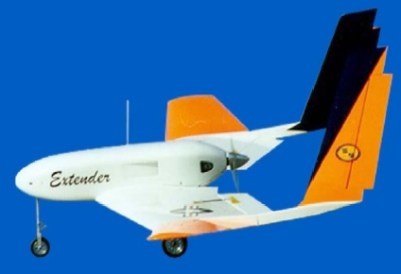Naval Research Lab Extender
The Extender was developed by the Naval Research Laboratory (NRL) in the 1998/2000 time frame as a canister-deployed, air-dropped electronic warfare UAV. The vehicle is stored in a 81.3 x 81.3 x 50.8 cm3 (32" x 32" x 20") container, which can simply be pushed out of a helicopter or transport aircraft. When air-dropped, a parachute is deployed, the container is shed, and the UAV folds its wings into flying position. Then the parachute is released and the electric motor started. Using LiSO2 batteries, Extender has an endurance of 2.3 hours with a maximum payload of about 3.2 kg (7 lb). With its GPS-based navigation system, it can either fly autonomous missions, or can be remotely controlled by an operator via an RF data link.
 |
| Photo: NRL |
| Extender |
The Extender has been flight-tested using conventional runways for take-off, and the air-drop mechanism has been demonstrated in a vertical wind tunnel. As of early 2001, the vehicle was ready for further mission-specific development, but the actual status at the time of this writing is unclear.
Specifications
Note: Data given by several sources show slight variations. Figures given below may therefore be inaccurate!
Data for Extender:
| Length | ? |
| Wingspan | 3.10 m (122 in) |
| Weight | 14.3 kg (31.5 lb) |
| Speed | 72 km/h (45 mph) |
| Endurance | 2.3 h |
| Propulsion | Electric motor |
Main Sources
Back to Directory of U.S. Military Rockets and Missiles, Appendix 4
Last Updated: 7 February 2006